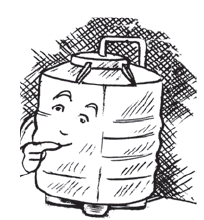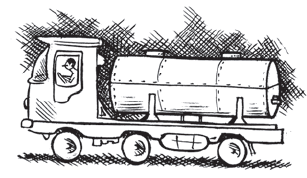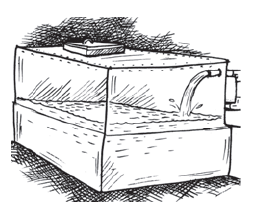NCERT Solutions for Class 8 Maths Chapter 9 - Mensuration - 3 (Exercise 9.3)
Exercise 9.3
Q1. Given a cylindrical tank, in which situation will you find surface area and in which situation volume.
(a) To find how much it can hold.
(b) Number of cement bags required to plaster it.
(c) To find the number of smaller tanks that can be filled with water from it.
Ans: (a) Volume (b) Surface area (c) Volume
Q2. Diameter of cylinder A is 7 cm, and the height is 14 cm. Diameter of cylinder B is 14 cm and height is 7 cm. Without doing any calculations can you suggest whose volume is greater? Verify it by finding the volume of both the cylinders. Check whether the cylinder with greater volume also has greater surface area? Ans: We can say that volume of cylinder B is greater, since radius of cylinder B is greater than that of cylinder A.
Ans: We can say that volume of cylinder B is greater, since radius of cylinder B is greater than that of cylinder A.
Find Volume for cylinders A and B
Diameter of cylinder A = 7 cm
Radius of cylinder A = 7/2 cm
And Height of cylinder A = 14 cm
Volume of cylinder A = πr2h
= (22/7 ) × (7/2) × (7/2) × 14 = 539
Volume of cylinder A is 539 cm3
Now, Diameter of cylinder B = 14 cm
Radius of cylinder B = 14/2 = 7 cm
And Height of cylinder B = 7 cm
Volume of cylinder B = πr2h
= (22/7) × 7 × 7 × 7 = 1078
Volume of cylinder B is 1078 cm3
Find the surface area of cylinders A and B
Surface area of cylinder A = 2πr(r + h )
= 2 × 22/7 × 7/2 × (7/2 + 14) = 385
Surface area of cylinder A is385 cm2
Surface area of cylinder B = 2πr(r + h)
= 2 × (22/7) × 7(7 + 7) = 616
Surface area of cylinder B is 616 cm2
Yes, the cylinder with greater volume also has a greater surface area.
Q3. Find the height of a cuboid whose base area is 180 cm2 and volume is 900 cm3?
Ans: Given, Base area of cuboid = 180 cm2 and Volume of cuboid = 900 cm3
We know that, Volume of cuboid = lbh
900 = 180 × h (substituting the values)
h= 900/180 = 5
Hence the height of the cuboid is 5 cm.
Q4. A cuboid is of dimensions 60 cm × 54 cm × 30 cm. How many small cubes with side 6 cm can be placed in the given cuboid?
Ans: Given, Length of cuboid, l = 60 cm, Breadth of cuboid, b = 54 cm and
Height of cuboid, h = 30 cm
We know that, Volume of cuboid = lbh = 60 ×54×30 = 97200 cm3
And Volume of cube = (Side)3
= 6 × 6 × 6 = 216 cm3
Also, the Number of small cubes = volume of cuboid / volume of cube
= 97200/216
= 450
Hence , the required number of cubes is 450.
Q5. Find the height of the cylinder whose volume is 1.54 m3 and diameter of the base is 140 cm
Ans: Given: Volume of cylinder = 1.54 m3and Diameter of cylinder = 140 cm
Radius (r)= d/2 = 140/2 = 70 cm
Volume of cylinder = πr2h
1.54 = (22/7) × 0.7 × 0.7 × h
After simplifying, we get the value of h, which is,
h = (1.54 × 7)/(22 × 0.7 × 0.7)
h = 1
Hence, the height of the cylinder is 1 m.
Q6. A milk tank is in the form of cylinder whose radius is 1.5 m and length is 7 m. Find the quantity of milk in litres that can be stored in the tank? Ans: Given, Radius of cylindrical tank, r = 1.5 m and Height of cylindrical tank, h = 7 m
Ans: Given, Radius of cylindrical tank, r = 1.5 m and Height of cylindrical tank, h = 7 m
Volume of cylindrical tank, V = πr2h
= (22/7) × 1.5 × 1.5 × 7
= 49.5 cm3
= 49.5 × 1000 liters = 49500 liters
[∵ 1 m3 = 1000 litres]
Hence, the required quantity of milk is 49500 litres.
Q7. If each edge of a cube is doubled,
(i) how many times will its surface area increase?
(ii) how many times will its volume increase?
Ans: (i) Let the edge of the cube be “ l” .
Formula for Surface area of the cube, A = 6 l2
When the edge of the cube is doubled, then
Surface area of the cube, say A’ = 6(2l)2 = 6×4l2 = 4(6 l2)
A’ = 4A
Hence, the surface area will increase by four times.
(ii) Volume of a cube, V = l3
When the edge of the cube is doubled, then
Volume of the cube, say V’ = (2l)3 = 8( l3)
V’ = 8×V
Hence, the volume will increase 8 times.
Q8. Water is pouring into a cubiodal reservoir at the rate of 60 litres per minute. If the volume of reservoir is 108 m3, find the number of hours it will take to fill the reservoir. Ans: Given, the volume of the reservoir = 108 m3
Ans: Given, the volume of the reservoir = 108 m3
Rate of pouring water into cuboidal reservoir = 60 litres/minute
= 60/1000 m3 per minute
= Since 1 liter = (1/1000 )m3
= (60 × 60)/1000 m3 per hour
= Therefore, (60 × 60)/1000 m3 water filled in reservoir will take = 1 hour
= Therefore 1 m3 water filled in reservoir will take = 1000/(60 × 60) hours
= Therefore, 108 m3 water filled in reservoir will take = (108 × 1000)/(60 × 60) hours = 30 hours
|
276 docs|155 tests
|

















